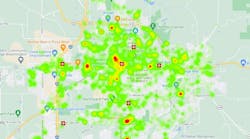The fire chief of 1823 took command of the fireground by bellowing orders through a brass trumpet, a carryover from decades before. One hundred years later, the technology available to the incident commander had not significantly improved. In fact, the FDNY did not christen their two-way radio system until 1953, with many other departments coming of age even later. Fast forward to the 21st. Century, where command staff as well as firefighters have unfettered access to varied methods of information exchange while responding to and operating at the scene of an emergency. The journey from trumpets to tablets has greatly improved both situational awareness and fireground safety, and this journey is far from its end. Ability is the key to modern fireground communications, and conversations now involve a mix of both voice and digitized data.
Compatibility
In this age of The Internet of Things, where your home thermostat can talk to your appliances, and your refrigerator restocks food, it is only fitting that the devices firefighters rely upon during emergencies can operate in a similar shared environment. This covers the range of improved metrics available in real-time. With modern day radios being intelligent tools far removed from the battery-gulping bricks of days gone by, every single member of the team has instantaneous access to more data than even the most well-informed incident commander of the past.
Interoperability
Just as the challenges facing firefighters have expanded, so too have their toolkits. One such tool is FirstNet, the nationwide communications system designed to provide border-to-border interoperability for first responders. While the focus of this program often looks at the global scale, there have been a number of cases where it has had a direct impact on local events. According to system architect AT&T, last year alone, FirstNet deployed almost 100 assets to 70 wildfires across 13 states. Elsewhere, the Hyannis Massachusetts Fire Department used specific portions of their offerings to outfit apparatus with routers, and to share livestream video from the fireground. The methodology used by FirstNet is part of a growing trend to integrate alternate communication methods such as Internet and wireless devices with conventional communications, and in some cases – replace it. A catalog of add-ons to further improve functionality lives here.
Penetrability
For years, the inability of radio waves to penetrate large buildings and sub-basement areas created a significant safety concern for firefighters. Neither maydays nor evacuation orders could be reliably heard. Thanks to standards such as NFPA 72 National Fire Alarm and Signal Code and the International Building Code, the use and specifications of Direct Antenna Systems (DAS) and Emergency Responder Radio Communications Systems (ERRCS) are clearly defined. The International Association of Fire Chiefs also provides valuable planning tools. Though not nearly providing full coverage in every existing building, efforts such as this are a giant step forward in firefighter safety.
Reliability
Much attention has also been given to the implementation of temporary services that can augment the normal means of communications, especially during serious emergencies or disasters. In addition to the features and functions of FirstNet, other avenues are available to augment and even replace front line systems during disasters. Verizon, for example, maintains a Frontline Crisis Response team, and assets such as THOR (Tactical Humanitarian Operations Response) Vehicle that can establish a local 5G network where service has been lost or overloaded.
Survivability
Not only have the ways that firefighters communicate changed, but so have the devices they communicate with. Since 2021, NFPA 1802 - Standard on Two-Way, Portable RF Voice Communications Devices for Use by Emergency Services Personnel in the Hazard Zone has raised the bar on radio survivability. Improved drop and impact performance along with better heat and water resistance provide increased reliability during normal operations and maydays, as well. Improvements such as larger emergency buttons and Bluetooth compatibility make for a more user friendly and adaptable hand-held. The latter also serves to interface these radios with other adjuncts such as in-mask SCBA microphones that provide significant improvements in voice clarity, and sets new standards for external microphones, as well. Enhanced displays that show battery life, audible announcements, color coding, and user programmable controls complete the package.
Communicability
While communicability often deals with the spreading of disease, when it comes to 2023 technology, communicability refers to the ease in which information is shared. Digital connections that include Bluetooth promote the rapid spread of both data and voice messages. Scottish researchers have designed a helmet that uses artificial intelligence to help “see” through smoke. It relies on radar, thermal imaging, and other sensors to help detect victims that might have otherwise been missed. Meanwhile, Queensland, Australia recently deployed Rosenbauer helmets equipped for hands-free communications, offering noise-cancelling performance with SCBA. A number of stand-alone solutions also offer improved communications while masked-up, an issue that has plagued the fire service for years.
Accessibility
Never before have there been more opportunities to use alternate means of communications to get the job done. While typical land mobile systems still carry the load, a number of other options exist. One such option comes from Siyata, in their Siyata 7 mission critical handset. Riding on conventional wireless networks, this device offers push to talk, emergency button, and other useful features. It can be used stand-alone or inserted into a vehicle mount for higher capacity and recharge. While not currently NFPA 1802 compliant, devices such as this offer a feature rich backup in a much more robust package than conventional cellular phones. Nonetheless, it has been reported that some departments are utilizing them for primary service, protecting the units by carrying them inside their turnouts.
Accountability
Perhaps no form of fireground communication is more important than that of accountability, and the rise of technology has moved this from tags and whiteboards to a totally new dimension. While these tools still work, automated mission times as well as up to date location tracking add beneficial elements. The FireGround Entry Control System by Drager consists of deployable components that track accountability electronically. Repeaters can be deployed that expand coverage within the fire structure. Scheduled to go live in a training mode with a fire department in November, Ascent Integrated Technologies components monitor firefighter biometrics, environmental, and location data. The firm recently placed first in Phase 4 of The First Responder Tracking Challenge conducted by the NIST, where they were able to pinpoint a target within three feet horizontally, and four inches vertically. These trials were conducted indoors under realistic conditions, without the assistance of GPS. Additional trials are scheduled for the fall. Concurrently, improved on-line mapping, both through civilian sources and service providers like the Critical Response Group assist in identifying and locating in-premise hazards, while providing responders with a more accurate view of their surroundings.
Applicability
If knowledge is power, then firefighters have never been stronger than today. The fusion of the Internet with more conventional communications systems allows instant access to a wide variety of custom engineered applications or “apps” that range from response notification, to hazardous material guidelines, to extrication and suppression information for electric vehicles. Some of the devices mentioned in this article also offer the potential for personalization/customization through downloads.
Manageability
Technology now allows the incident commander to integrate a variety of platforms and displays onto a single device through the use of technology such as Motorola’s CommandCentral which can tie together data from such disparate sources such as radio, computer aided dispatch, social media, mapping, floor plans, telephone, streaming videos, and records through the cloud. Having information from numerous pertinent sources provides an electronic 360 interactive view that provides for enhanced awareness and improved decision making.
Possibility
Manufacturers are mentioned by name for reference purposes only. Neither Firehouse.com nor the author have received any compensation for their inclusion. Agencies are encouraged to investigate all sources of technology which may be applicable to their operations. In 2023, the possibilities are almost endless.






